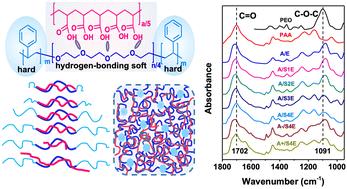当前位置:
X-MOL 学术
›
Polym. Chem.
›
论文详情
Our official English website, www.x-mol.net, welcomes your
feedback! (Note: you will need to create a separate account there.)
Structure, humidity adaptivity, and elasticity of hydrogen-bonded complexes formed by self-assembly of a triblock copolymer and a homopolymer
Polymer Chemistry ( IF 4.1 ) Pub Date : 2024-11-06 , DOI: 10.1039/d4py00959b Weijie Wang, Hanxin Jian, Hao Huang, Fengfeng Feng, Qingye Meng, Yuli Li, Gang Chen, Shuguang Yang
Polymer Chemistry ( IF 4.1 ) Pub Date : 2024-11-06 , DOI: 10.1039/d4py00959b Weijie Wang, Hanxin Jian, Hao Huang, Fengfeng Feng, Qingye Meng, Yuli Li, Gang Chen, Shuguang Yang

|
Specific aggregation structures largely influence the macro-physical performances of materials. Small changes in molecular components, conformation, crystallisation and microphase transitions can dramatically alter material properties. Here, we combine the triblock copolymer polystyrene-b-poly(ethylene oxide)-b-polystyrene (SES) with the homopolymer poly(acrylic acid) (PAA), fabricating elastomers with multi-hierarchical architectures. Unlike the single molecular chain of traditional elastomers, the flexible domain of these elastomers is formed via hydrogen bonding of the complex chains (A/E) of poly(ethylene oxide) (PEO) and PAA. The polystyrene (PS) blocks are microphase-separated and hydrophobically associated, providing physical crosslinks among the flexible complex chains and enhancing the strength of the elastomers. The influence of the molecular weight of the PS blocks, molecular chain length of PAA, and relative humidity on the elastomer's macro-physical properties was revealed using small-angle X-ray scattering, transmission electron microscopy, differential scanning calorimetry, Fourier transform infrared spectroscopy, and tensile stress–strain measurements. The PS block forms a hard spherical domain that affects the hydrogen-bonding complex behaviours of the PAA and PEO segments. Enlarging the PS sphere would hinder the formation of the PAA/PEO complex, but this trend is mitigated by shortening the PAA chain length. Hydrophobic steric hindrance by the PS sphere disturbs the association behaviours of the PAA and PEO segments. These structural differences result in different mechanical properties of the elastomers. Moreover, the elastomers adapt to changes in the relative humidity and show an obvious humidity-induced glass transition. The elastomers possess good elasticity properties under low and high humidity conditions. The methods and ideas presented in this study will enable the construction of new types of elastomers.
中文翻译:

三嵌段共聚物和均聚物自组装形成的氢键配合物的结构、湿度适应性和弹性
特定的聚集结构在很大程度上影响材料的宏观物理性能。分子成分、构象、结晶和微相转变的微小变化都会极大地改变材料特性。在这里,我们将三嵌段共聚物聚苯乙烯-b-聚(环氧乙烷)-b-聚苯乙烯 (SES) 与均聚物聚丙烯酸 (PAA) 相结合,制造出具有多层次结构的弹性体。与传统弹性体的单分子链不同,这些弹性体的柔性域是通过聚环氧乙烷 (PEO) 和 PAA 的复杂链 (A/E) 的氢键形成的。聚苯乙烯 (PS) 嵌段是微相分离和疏水结合的,在柔性复杂链之间提供物理交联并增强弹性体的强度。使用小角 X 射线散射、透射电子显微镜、差示扫描量热法、傅里叶变换红外光谱和拉伸应力-应变测量揭示了 PS 嵌段的分子量、PAA 的分子链长度和相对湿度对弹性体宏观物理特性的影响。PS 嵌段形成一个坚硬的球形结构域,影响 PAA 和 PEO 链段的氢键络合物行为。扩大 PS 球体会阻碍 PAA/PEO 复合物的形成,但这种趋势可以通过缩短 PAA 链长度来缓解。PS 球体的疏水空间位阻干扰了 PAA 和 PEO 片段的结合行为。这些结构差异导致弹性体的机械性能不同。 此外,弹性体适应相对湿度的变化,并显示出明显的湿度诱导玻璃化转变。弹性体在低湿度和高湿度条件下具有良好的弹性。本研究中提出的方法和想法将使构建新型弹性体成为可能。
更新日期:2024-11-06
中文翻译:

三嵌段共聚物和均聚物自组装形成的氢键配合物的结构、湿度适应性和弹性
特定的聚集结构在很大程度上影响材料的宏观物理性能。分子成分、构象、结晶和微相转变的微小变化都会极大地改变材料特性。在这里,我们将三嵌段共聚物聚苯乙烯-b-聚(环氧乙烷)-b-聚苯乙烯 (SES) 与均聚物聚丙烯酸 (PAA) 相结合,制造出具有多层次结构的弹性体。与传统弹性体的单分子链不同,这些弹性体的柔性域是通过聚环氧乙烷 (PEO) 和 PAA 的复杂链 (A/E) 的氢键形成的。聚苯乙烯 (PS) 嵌段是微相分离和疏水结合的,在柔性复杂链之间提供物理交联并增强弹性体的强度。使用小角 X 射线散射、透射电子显微镜、差示扫描量热法、傅里叶变换红外光谱和拉伸应力-应变测量揭示了 PS 嵌段的分子量、PAA 的分子链长度和相对湿度对弹性体宏观物理特性的影响。PS 嵌段形成一个坚硬的球形结构域,影响 PAA 和 PEO 链段的氢键络合物行为。扩大 PS 球体会阻碍 PAA/PEO 复合物的形成,但这种趋势可以通过缩短 PAA 链长度来缓解。PS 球体的疏水空间位阻干扰了 PAA 和 PEO 片段的结合行为。这些结构差异导致弹性体的机械性能不同。 此外,弹性体适应相对湿度的变化,并显示出明显的湿度诱导玻璃化转变。弹性体在低湿度和高湿度条件下具有良好的弹性。本研究中提出的方法和想法将使构建新型弹性体成为可能。


















































 京公网安备 11010802027423号
京公网安备 11010802027423号